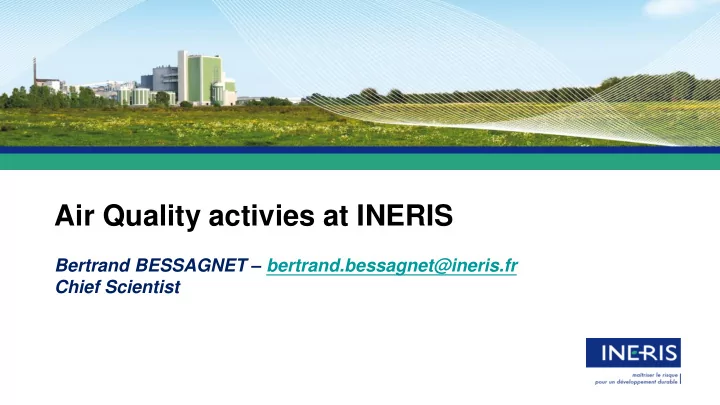

Air Quality activies at INERIS Bertrand BESSAGNET – bertrand.bessagnet@ineris.fr Chief Scientist
INERIS in brief 2
INERIS, the reference organisation for Air Quality at national and European Levels ➢ INERIS is a member of the Central Laboratory for Air Quality Monitoring (AQM) in charge of: ▪ the coordination of the air quality monitoring strategy in France, ▪ support the Ministry of the Environment for decision making, negotiations of the regulations and communication, ▪ coordination and support of local organizations (AASQA) in charge of AQM ➢ INERIS supports French authorities for the implementation of air quality management strategies and negotiation of international legislations (e.g. European AQ Directives or protocols of the UN Convention on Long Range transboundary air pollution) ➢ INERIS develops the French national air quality model with the national scientific center (CNRS) for forecasting and scenario analysis 3
Use of models to complete the monitoring strategy The CHIMERE model (partly developed by INERIS) Strengths: Easy to implement, free Useable in the world State of the art model Works on HPC or linux cluster 4
International experience International expertise in ➢ European Copernicus services for EU authorities: environmental Air Quality Management monitoring services implementation ▪ INERIS is a leader of COPERNICUS services related to policy support and a key player of the COPERNICUS forecasting platform ➢ Chair of the EMEP program supporting the UN Convention on Long-range Transboundary Air Pollution (Laurence Rouïl) ➢ INERIS as a partner of the European Topic Centre for Air Pollution and Climate Change Mitigation for the European Environmental Agency ➢ Close cooperation with international institutions like EU JRC, IIASA, ECMWF ➢ INERIS works for customers worldwide in Senegal, Chile, Tunisia (via Aria ) and China (BMILP) 5
The french air quality forecasting system PRE’VAIR (www.prevair.org) ➢ An operational system that has become a part of the French air quality monitoring strategy. ➢ A new approach, borne by numerical tools, to reinforce the air quality management network, with new products : ▪ Forecasts: since 2003, public information procedures and emergency measures are based not only on measurements but also on forecasts. • Regulatory pollutants: O3, NO2 and PM • Global / European / French scales • 3 days ahead Prevention of exposure 6
The national air quality forecating system PREV’AIR 7
Use of observational data in PREV’AIR Use of statistical data to improve the raw simulations 8
From the regional scale … 9
…to the local scale ➢ Use of different types of models to asses the local impact of industrial plants ➢ Chronic release ▪ Mapping of mean concentration and deposition of pollutant over period of 3-5 years. ▪ Estimation and localization of the maximum MSS by ARIA Technologies impacted area ➢ Accidental release ▪ Find the maximum concentration an fallout of pollutants ▪ Calculate the Effective Dose computation 10
Case of the Icelandic volcano eruption in April 2010 ➢ Evaluation of the consequences on Use of models to track the pollution plume air quality in France In-situ observations of the plume around Paris 11
Simulation at the global scale (anthropic PM2.5) March 5 th -18 th , 2014 12
Impact of dust emissions on air quality 13
Assessment of the transboundary air pollution ➢ Exemple: Evaluation of the impact of foreign emissions (in %) for PM10 ➢ Method: remove the national emissions in the model 14
Scenario analysis during episodes Reduction effect on ammonium nitrate concentrations : -30% of french agricultural NH3 versus -30% of french traffic NOx 15
Scenario analysis for long term policies Evolution of PM10 concentrations according to the Directives on emissions Evaluation of individual measures at the national scale to reduce air pollution • Cost / benefices analysis (avoided cost on health) • Impact on air quality 16
Air quality and Climate Change Suite of models 17
Cost benefit analysis of emission reduction measures 600 ➢ Integrating Air Pollution policy in Climate policy in policy brings 500 additional benefits in terms of GHG 400 reductions, at negligible cost € billion/year 300 ➢ Additional costs for the energy system 200 are almost offset by Additional 100 benefits in terms of reduced AP mitigation costs, and by additional - health benefits Air pollution Energy systems AP mitigation & Monetised -100 mitigation costs costs energy systems health damage costs ➢ Measures can be tested REF MIT Increment (MIT-REF) independently 18
French Expertise in Air Pollution Integrated solutions for Air Pollution Monitoring and Management 19
20 20
Synergies between the partners for integrated or tailor made solutions • Different status : private, public and research organisations • Different products : stations, models, lidars • Different expertises : network design, impact and cost assesments, health impacts and public exposure (indoor, outdoor), advising authorities , public information … 21
Summary ➢ Expertise on air quality management including modelling (and also emission and ambient measurements) ➢ Air quality forecasting (local, regional and global scale) – Impact of industrial facilities (on line forecasting of industrial plants ➢ Scenario analysis – cost benefit analysis of mtigation measures ➢ Assessment of the transboundary pollution ➢ Air quality & Climate change ➢ Integrated views from emissions to health impacts (Health risk assesment studies) 22
Recommend
More recommend